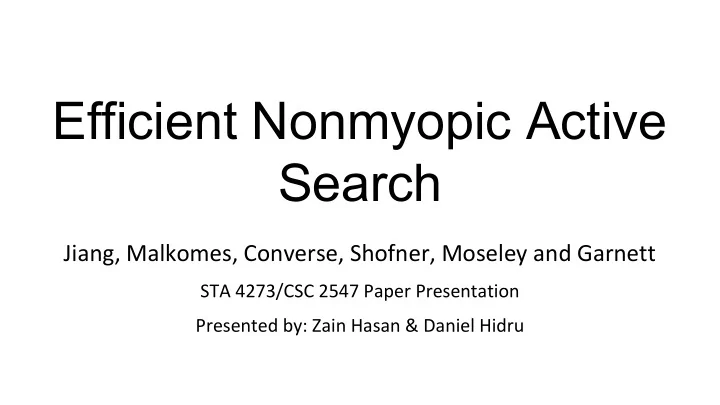

Efficient Nonmyopic Active Search Jiang, Malkomes, Converse, Shofner, Moseley and Garnett STA 4273/CSC 2547 Paper Presentation Presented by: Zain Hasan & Daniel Hidru
Active Search ● Sequentially locating as many members of a particular class as possible - targets that belong to a rare class ● Active search is Bayesian optimization with binary rewards and cumulative regret (budget).
Analogy for Active Search ● Writing a Literature Review is an active search process Limited amount of papers you can read (budget) ○ Reading papers you know are relevant (exploitation) ○ Reading papers that might be relevant in the hope that you find more ○ relevant papers (exploration)
Budget (Cumulative regret) ● You have limited time (deadline) and resources. ● Have to balance between exploration and exploitation to maximize utility for binary y = {0,1}: ● Which counts the number of targets in chosen set (ie. Relevant papers included in review) ● Want to determine/approximate some optimal policy of picking points that maximizes utility
Myopic vs. Nonmyopic ● Myopic search: consider the effect of only potential immediate choices Easier, lower runtime complexity, but short-sighted ○ ● Nonmyopic search: consider impact of all selected points, immediate and future Harder, more complex, but potentially better results ○
Contributions of Paper 1. Prove that active search, that approximates the optimal policy, is hard to do by finding its runtime complexity via a proof 2. Suggest an efficient nonmyopic search algorithm
Background for Algorithm ● Optimal Bayesian Decision/Policy: Posterior prob. of a point belonging to desired y = 1 class ○ ● Choose next points maximizing the expected number of targets found at termination, given i - 1 previous observations:
Expected utility: 1 query left Expected utility of selecting x t , given previous selections (D t-1 ) = Reward for previous selections + Expected reward of current selection ● Pure exploitation because there are no more queries to make
Expected utility: 2 queries left Expected utility of selecting x t-1 , given previous selections (D t-2 ) = Reward for previous selections + Expected reward of current selection + Expected reward for final selection given outcome of current selection ● Natural trade off between exploitation (2nd term) and exploration (3rd term)
Expected utility: t-i+1 queries left Expected utility of selecting x i , given previous selections (D i-1 ) = Reward for previous selections + Expected reward of current selection + Expected reward for remaining selections given outcome of current selection ● Can compute this expectation recursively Cost: exponential in the number of future queries - O((2n)^l) ○
Hardness of Approximation
Efficient Nonmyopic Search (ENS): t-i+1 queries left Expected utility of selecting x i , given previous selections (D i-1 ) ≈ Reward for previous selections + Expected reward of current selection + Expected reward for remaining selections given they are selected as a batch ● Assumption: the labels of all unlabeled points are conditionally independent Needed to reduce the final term to a sum of marginal probabilities ○
Assumptions for efficiency improvements 1. Updating the model only affects a limited number of samples. 2. Observing a new negative point will not raise the probability of any other point being a target. 3. Able to bound the maximum probability of the unlabeled data conditioned on the future selection of additional targets.
Representative experiment: CiteSeer data ● Data: 39,788 computer science papers published in the top 50 venues ○ ○ 2,190 (5.5%) are NIPS publications ● Goal: Find the most NIPS publications given a budget t=500 ● Model: k-NN with k=50 Easy to update ○ ○ Consistent with efficiency assumptions ● Features: graph PCA on the citation network using the first 20 principal components
Results: All 500 queries Image: https://bayesopt.github.io/slides/2016/ContributedGarnett.pdf
Results: First 80 queries Image: https://bayesopt.github.io/slides/2016/ContributedGarnett.pdf
Results: Different budgets Image: https://bayesopt.github.io/slides/2016/ContributedGarnett.pdf
Relationship to other fields of research ● Active learning: train a high performing model with a few selected examples AS: find elements of a rare class with a few selected choices ○ ● Multi-armed bandit: maximize expected score given limited resources AS: items are correlated and can only be selected once ○ ○ ENS similar to knowledge gradient policy (Frazier et al., 2008) ● Bayesian optimization: global optimization using sequential choices AS: special case with binary observations and cumulative reward ○ ○ ENS similar to GLASSES algorithm (González et al., 2016)
Limitations (related to this course) and future work ● Active Search/ENS Approach ○ Can’t select the same element multiple times ■ Difficult to apply to reinforcement learning where the same action can be repeated ○ Can’t work in a continuous object domain ■ Needs discrete objects that can’t be selected multiple times to avoid selecting objects that are arbitrarily close to a previously selected item ○ True reward does not depend on previous actions ■ The order of the decisions affects your performance in reinforcement learning ● Bayesian Optimization ○ Probability models need to be updated multiple times before each selection ■ Costly to retrain neural networks (idea: update with a few gradient steps) ○ Difficult to work with continuous labels/rewards ■ Challenging to integrate the expected future reward (idea: estimate expectation)
Summary ● Efficient Nonmyopic Search outperforms myopic search in the active search problem by considering the benefit of exploration associated with the rewards of future queries. ● The key idea will be difficult to utilize in our course projects because it depends on many of the constraints imposed by the problem definition.
References ● Jiang, S., Malkomes, G., Converse, G., Shofner, A., Moseley, B. and Garnett, R., 2017, July. Efficient Nonmyopic Active Search. In International Conference on Machine Learning (pp. 1714-1723). ● Garnett, R., 2016, October. Efficient Nonmyopic Active Search. https://bayesopt.github.io/slides/2016/ContributedGarnett.pdf ● Frazier, P.I., Powell, W.B. and Dayanik, S., 2008. A knowledge-gradient policy for sequential information collection. SIAM Journal on Control and Optimization, 47(5), pp.2410-2439. ● González, J., Osborne, M. and Lawrence, N., 2016, May. GLASSES: Relieving the myopia of Bayesian optimisation. In Artificial Intelligence and Statistics (pp. 790-799).
Recommend
More recommend